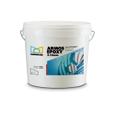-

ARMOS EPOXY
TWO COMPONENT EPOXY GROUT 2-12 mm
Two component epoxy grout, with high mechanical resistance. It is classified as RG according to ΕΝ 13888.
PACKAGING:
3 & 6kg
COLOR:
Light grey
Dark grey
Brown grey
Light blue
White
CHARACTERISTICS:
Application Temperature
+7°C to +35°C
Application Tools
Rubber spatula, wet sponge, soft cloth
Consumption
Approx. 85 – 730 gr/m², depending on the joint and size (dimensions) of the tile
Open Application Time
At least 120 min. (23°C – 50% humidity)
-
Uses
Suitable
- for surfaces that require high resistance to mechanical loads and chemical effects, as well as waterproofing
- for grouting ceramic and natural stone tiles, indoors and outdoors, on walls and floors, in industrial and commercial premises such as food industries (dairies, canneries, wineries, breweries, slaughterhouses etc.), commercial refrigerators and freezers
- for business environments with high hygiene requirements (butchers, fishmongers, kitchens etc.)
- for industries and chemical laboratories, wastewater storage tanks, public toilets etc.
- for tanks containing chemicals and pools with saltwater or spa water.
- for 2-12 mm joint widths
-
-
Advantages
- It is unaffected by acids, bases, corrosive cleaners, salt water, chlorine, etc.
- It has very good adhesion and is very durable.
- It can be applied very easily, on vertical and horizontal surfaces, and can be cleaned by using hard sponges and clean water.
-
- The joints must be dry and free from dust, grease and loose particles.
- Add component B (hardener) into component A (epoxy resin) and mix well with an electric mixer, for 2-3 minutes at low speed (400 rpm /min), until you get a homogeneous mixture with uniform color.
- Make grouting with a rubber spatula, pushing the mixture sideways and diagonally to the joints, until they are filled correctly. At the same time remove the excess material from the surface of the tiles using a hard damp sponge.
- Make the final cleaning with a soft sponge (and possibly lukewarm water), moving the sponge diagonally. Thus the joint is smoothed and any grout remaining is removed from the surface of the tiles.
- The use of alcohol facilitates the final cleaning.
- It is important to often rinse the sponge, with clean water, during the cleaning process.
In intact packaging and dry environment, 12 months from the production date
Previous product
Next product




